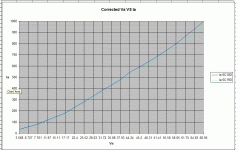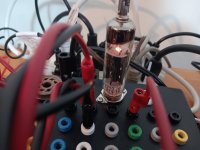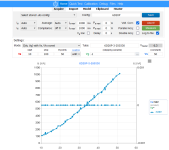Hi,
To make a long story short, I'm working on a SET design with a slightly complex PSU design (200, 270 and 380Vdc from three separate transformer windings).
I plan to use 2x 6AU4GTA in a hybrid bridge for the 380V rail (@140mA) and I also wish to use vacuum diodes for the other two (20mA and 100mA respectively).
To keep the costs down I've been looking at russian dampers (6D14P and 6D20P) for the input and driver tube supply rails but I can't quite figure out how to interpret the heater-cathode insulation ratings in the datasheets:

Would it be safe (in long terms) to use these tubes as rectifiers up to less than 300Vdc with the heaters referenced to ground?
I could connect the heaters to the cathodes but would prefer not to if possible, no other tubes will be powered by the same heater windings though.
To make a long story short, I'm working on a SET design with a slightly complex PSU design (200, 270 and 380Vdc from three separate transformer windings).
I plan to use 2x 6AU4GTA in a hybrid bridge for the 380V rail (@140mA) and I also wish to use vacuum diodes for the other two (20mA and 100mA respectively).
To keep the costs down I've been looking at russian dampers (6D14P and 6D20P) for the input and driver tube supply rails but I can't quite figure out how to interpret the heater-cathode insulation ratings in the datasheets:

Would it be safe (in long terms) to use these tubes as rectifiers up to less than 300Vdc with the heaters referenced to ground?
I could connect the heaters to the cathodes but would prefer not to if possible, no other tubes will be powered by the same heater windings though.
This rectifier is for 405 line VHF television line stage recovery.
As long as the voltage doesn't exceed 7kv for more than 15uS it should be OK.
As long as the voltage doesn't exceed 7kv for more than 15uS it should be OK.
My read of the attached data sheet for the 6D14P is that the heater to cathode insulation is rated for 100 volts DC when the heater is positive to the cathode and 750V DC cathode to heater when the heater is negative to the cathode.but I can't quite figure out how to interpret the heater-cathode insulation ratings in the datasheets:
Also rated for 5.6KV positive cathode to heater for a 12uS pulse.
The 6C10P is similar except there is no voltage rating for heater positive to cathode.
I expect this may well be a data sheet omission and find errors and omissions in Russian data sheets pretty common.
The 6C19P is similar to the 6D14P just not as clearly written in the data sheet.
So for a full wave CT supply or 1/2 wave positive output voltage where the cathode rises to the positive B+ voltage you would be fine up to a 750V dc supply.
I personally would not push it any where near that far but 300V~450V DC on the cathode with the heater at ground seems reasonable.
I have used these in many builds and two tubes work well as a 5AR4 replacements using a 6.3V supply.
You could consider to use the 6D14P for your main 380V 140mA B+ as well.
My last build used a pair of 6D14P for a 510V DC, 145mA full wave CT capacitor input supply and they seem happy.
You may experience a bit more voltage drop than with 6AU4GTA but if you watch the peak current in the supply design you should be fine.
My personal experience is theses tubes are pretty tough and very cheep.
Attachments
Last edited:
Thanks for your replies!
I've done some searches using Google Translate and these tubes seem fairly popular as HT rectifiers among russian audiophiles, though I haven't found much information about how they arrange the heaters.
I've done some searches using Google Translate and these tubes seem fairly popular as HT rectifiers among russian audiophiles, though I haven't found much information about how they arrange the heaters.
Here is Va vs Ia raw data I collected with a uTracer6 on the 6C10D and the 6C19D.
The chart shows the Va vs Ia is close between a 6C10D and a 6C19D with the 6C19D having a bit more voltage drop.
A 6D14P measures in my experience similar to a 6C10D. As I have no samples I do not have any data on a 6D20P.
Keep in mind the accuracy of a uTracer6 below 20 volts is limited.
I attached a spice model I created of the 6C10P. I have not found other trustworthy spice models for Russian damper tube rectifiers.
The model is in pspice format but will likely work fine with LTspice.
I find this model a good match using a transient simulation analysis of the full power supply compared to real tubes in a bench setup with a full wave CT capacitor power supply. It saves a lot of guess work.
The chart shows the Va vs Ia is close between a 6C10D and a 6C19D with the 6C19D having a bit more voltage drop.
A 6D14P measures in my experience similar to a 6C10D. As I have no samples I do not have any data on a 6D20P.
Keep in mind the accuracy of a uTracer6 below 20 volts is limited.
I attached a spice model I created of the 6C10P. I have not found other trustworthy spice models for Russian damper tube rectifiers.
The model is in pspice format but will likely work fine with LTspice.
I find this model a good match using a transient simulation analysis of the full power supply compared to real tubes in a bench setup with a full wave CT capacitor power supply. It saves a lot of guess work.
Attachments
Today I received some samples of the 6D20P damper tube.
Looking at the physical size of the 6D20P cathode it looks over twice the size of a cathode in each 5AR4 diode.
Consider also the power drawn by the 6D20P cathode. @ 6.3V 1.8A or 11.34 watts.
Compare this to one diode in a 5AR4 @ only 5 watts.
The 6D20P's very large high power cathode seems likely to be able to emit a lot of electrons.
The 6D20P does eat a LOT of filament power and so the tube gets hot from just the filament.
I am not sure providing about 3.6 amps of 6.3 of filament power for a pair makes sense for most designs but than again....why not.
Testing three sample tubes in my uTracer6 they supply about 1A current @ between 45 to 51 volts drop.
At a more reasonable peak current of 600mA the 6D20P voltage drop is about 31 volts, just slightly better than a 5AR4 at 32.5V drop.
To compare the 6C19P and 6C10P have about a 40V drop at 600mA peak current.
I attached 3 I/V data charts for three samples of the 6D20P
If my experience with the 6C19P and 6C10P is any guide a 6D20P will withstand very hard use that would kill a current production 5AR4 in short order.
Looking at the physical size of the 6D20P cathode it looks over twice the size of a cathode in each 5AR4 diode.
Consider also the power drawn by the 6D20P cathode. @ 6.3V 1.8A or 11.34 watts.
Compare this to one diode in a 5AR4 @ only 5 watts.
The 6D20P's very large high power cathode seems likely to be able to emit a lot of electrons.
The 6D20P does eat a LOT of filament power and so the tube gets hot from just the filament.
I am not sure providing about 3.6 amps of 6.3 of filament power for a pair makes sense for most designs but than again....why not.
Testing three sample tubes in my uTracer6 they supply about 1A current @ between 45 to 51 volts drop.
At a more reasonable peak current of 600mA the 6D20P voltage drop is about 31 volts, just slightly better than a 5AR4 at 32.5V drop.
To compare the 6C19P and 6C10P have about a 40V drop at 600mA peak current.
I attached 3 I/V data charts for three samples of the 6D20P
If my experience with the 6C19P and 6C10P is any guide a 6D20P will withstand very hard use that would kill a current production 5AR4 in short order.
Attachments
Great information, thanks!
I decided to try 6AX5GT as rectifiers for the two lower rails in my PSU but practical tests revealed that they drop a little too much voltage.
At least the 270V 100mA rail for the driver tubes would benefit from better rectifiers so I'm looking at trying 6D20P or EY88 later on.
I decided to try 6AX5GT as rectifiers for the two lower rails in my PSU but practical tests revealed that they drop a little too much voltage.
At least the 270V 100mA rail for the driver tubes would benefit from better rectifiers so I'm looking at trying 6D20P or EY88 later on.
The European equivalent of the 6D20P tube is the EY88, isn't it? It's cathode is heated by radiation without any mechanical contact between the heater and the cathode sleeve. Hence it's relatively large heater power that doesn't allow sensible comparisons with the GZ34/5AR4.
Best regards!
Best regards!
Consider the 6C19P, 6C10P and 6D14P.270V 100mA rail for the driver tubes would benefit from better rectifiers so I'm looking at trying 6D20P or EY88 later on.
All three have a much lower voltage drop than a 6AX5.
6AX5 voltage drop, 55V @200mA
6C19P, 6C10P and 6D14P voltage drop, about 18V @200mA
At 1.05A 6.3V filament current the the 6C19P, 6C10P and 6D14P have much lower power requirement than the 1.8A for the 6D20P
The 6C19P, 6C10P and 6D14P are lower is cost and more common than the 6D20P.
Well, I don't know how much all these Russian damper diodes cost, but there's a German vendor who sells EY88's at € 0.22/pc. Still too expensive?
Best regards!
Best regards!
I agree the heater is of a different design and do not doubt the 6D20P is a less efficient heater design than the 5AR4.It's cathode is heated by radiation without any mechanical contact between the heater and the cathode sleeve. Hence it's relatively large heater power that doesn't allow sensible comparisons with the GZ34/5AR4.
That does not to me fully explain all the heater power difference.
If you go on to compare the surface area of the actual cathode of a diode in a 5AR4 and the cathode surface area of a 6D20P the 6D20P has a cathode surface area that is at least two times the size of the 5AR4.
So I see a substantial amount of the additional power likely is being consumed in powering what is really a huge cathode surface area on a 6D20P.
Given the same basic cathode technology larger area cathodes would seem to be a advantage when high peak currents need to be delivered.
Last edited:
LOLWell, I don't know how much all these Russian damper diodes cost, but there's a German vendor who sells EY88's at € 0.22/pc. Still too expensive?
That is low cost.
I have plenty of heater current available so pretty much any of the alternatives would work. All of them are pretty cheap too, both the russian and the western ones, so it basically comes down to finding a a place where I can buy a lifetime supply without paying too much for shipping and import charges. Not a real problem, this is for a 300B SET with DHT drivers and two interstage transformers per channel so the price of a few TV tubes are just a drop in the ocean.
I tried 6AX5GT because I have a few and they look a bit better than novals with top caps but I ended up with 195 and 255V respectively. Quite close but I would prefer to have 10-20V more on each rail.
Re. the heater efficiency, I think the damper diodes pay a high efficiency penalty due to the high heater-cathode insulation?
I tried 6AX5GT because I have a few and they look a bit better than novals with top caps but I ended up with 195 and 255V respectively. Quite close but I would prefer to have 10-20V more on each rail.
Re. the heater efficiency, I think the damper diodes pay a high efficiency penalty due to the high heater-cathode insulation?
Yes, that's what I said. The heater is losely wound around a central ceramic rod and fixed by a helically wound thin wire. There's about 1 mm of space everywhere between this construction and the cathode sleeve.
Best regards!
Best regards!
Tried to buy a few EY88's from them...the payment was refused,saying that they don't send in my country (Croatia).Weird policy as Croatia is an EU member.Curious if their sales restrictions apply to others.Well, I don't know how much all these Russian damper diodes cost, but there's a German vendor who sells EY88's at € 0.22/pc. Still too expensive?
Best regards!
From where did you get that information? Did you dissect one?Its cathode is heated by radiation without any mechanical contact between the heater and the cathode sleeve.
As it happens, I found I had a single PY88, so that nice photograph of the internals has saved it from being dissected. Interesting construction, and one that wants thinking about, particularly that helix between the heater and unipotential cathode. There's something to be learned there...
That's about what I said. The Central ceramic rod that I mentionrd isn't there, though. Maybe It's deppendent of the manufacturer, maybe I've puzzled IT with the PY500A construction.
Best regards!
Best regards!
- Home
- Amplifiers
- Tubes / Valves
- Russian TV damper diode (6D20P) heater-cathode voltage


